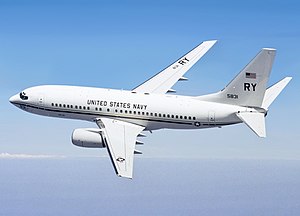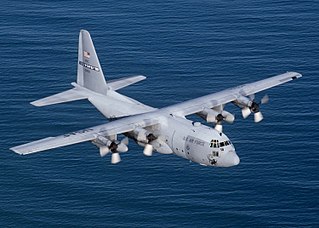
The Lockheed C-130 Hercules is an American four-engine turboprop military transport aircraft designed and built by Lockheed. Capable of using unprepared runways for takeoffs and landings, the C-130 was originally designed as a troop, medevac, and cargo transport aircraft. The versatile airframe has found uses in other roles, including as a gunship (AC-130), for airborne assault, search and rescue, scientific research support, weather reconnaissance, aerial refueling, maritime patrol, and aerial firefighting. It is now the main tactical airlifter for many military forces worldwide. More than 40 variants of the Hercules, including civilian versions marketed as the Lockheed L-100, operate in more than 60 nations.
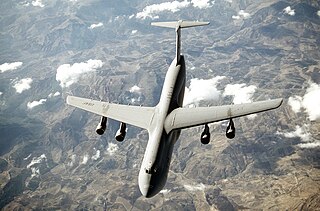
The Lockheed C-5 Galaxy is a large military transport aircraft designed and built by Lockheed, and now maintained and upgraded by its successor, Lockheed Martin. It provides the United States Air Force (USAF) with a heavy intercontinental-range strategic airlift capability, one that can carry outsized and oversized loads, including all air-certifiable cargo. The Galaxy has many similarities to the smaller Lockheed C-141 Starlifter and the later Boeing C-17 Globemaster III. The C-5 is among the largest military aircraft in the world.

The McDonnell Douglas C-9 is a retired military version of the McDonnell Douglas DC-9 airliner. It was produced as the C-9A Nightingale for the United States Air Force, and the C-9B Skytrain II for the U.S. Navy and Marine Corps. The final flight of the C-9A Nightingale was in September 2005, and the C-9C was retired in September 2011. The U.S. Navy retired its last C-9B in July 2014. The two remaining C-9s in Marine service were retired in April 2017.

The Boeing T-43 is a modified Boeing 737-200 that was used by the United States Air Force for training navigators, now known as USAF combat systems officers, from 1973 to 2010. Informally referred to as the Gator and "Flying Classroom", nineteen of these aircraft were delivered to the Air Training Command (ATC) at Mather Air Force Base, California during 1973 and 1974. Two additional aircraft were delivered to the Colorado Air National Guard at Buckley Air National Guard Base and Peterson Air Force Base, Colorado, in direct support of cadet air navigation training at the nearby U.S. Air Force Academy. Two T-43s were later converted to CT-43As in the early 1990s and transferred to Air Mobility Command (AMC) and United States Air Forces in Europe (USAFE), respectively, as executive transports. A third aircraft was also transferred to Air Force Materiel Command (AFMC) for use as the "Rat 55" radar test bed aircraft and was redesignated as an NT-43A. The T-43A was retired by the Air Education and Training Command (AETC) in 2010 after 37 years of service.
Boeing Business Jets (BBJ) are versions of Boeing's jet airliners with modifications to serve the private, head of state, and corporate jet market. The jets are capable of flying more than 6,000 nautical miles nonstop and offers more cabin space than traditional long-range business jets. The first BBJ, based on the 737-700, rolled out on July 26, 1998; and had its first flight on September 4, 1998.

Naval Air Station Jacksonville is a large naval air station located approximately eight miles (13 km) south of the central business district of Jacksonville, Florida, United States.
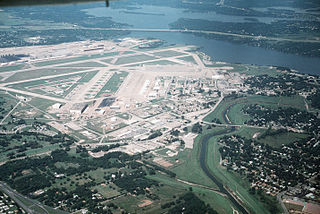
Naval Air Station Joint Reserve Base Fort Worth includes Carswell Field, a military airbase located 5 nautical miles west of the central business district of Fort Worth, in Tarrant County, Texas, United States. This military airfield is operated by the United States Navy Reserve. It is located in the cities of Fort Worth, Westworth Village, and White Settlement in the western part of the Fort Worth urban area.

The Military Air Transport Service (MATS) is an inactive Department of Defense Unified Command. Activated on 1 June 1948, MATS was a consolidation of the United States Navy's Naval Air Transport Service (NATS) and the United States Air Force's Air Transport Command (ATC) into a single joint command. It was inactivated and discontinued on 8 January 1966, superseded by the Air Force's Military Airlift Command (MAC) as a separate strategic airlift command, and it returned shore-based Navy cargo aircraft to Navy control as operational support airlift (OSA) aircraft.

Naval Air Facility Washington or NAF Washington is a United States Naval Reserve installation located near Camp Springs, Maryland in the United States of America. The facility was established at Andrews Air Force Base in 1958. As part of the 2005 Base Realignment and Closure (BRAC) program, it merged with Andrews Air Force Base in 2009, to create Joint Base Andrews-Naval Air Facility Washington.

The Boeing Model 40 was a United States mail plane of the 1920s. It was a single-engined biplane that was widely used for airmail services in the United States in the 1920s and 1930s, especially by airlines that later became part of United Airlines. It became the first aircraft built by the Boeing company to carry passengers.

The 932nd Airlift Wing is an Air Force Reserve Command flying unit. It is assigned to the Twenty-Second Air Force, Air Force Reserve Command, stationed at Scott Air Force Base, Illinois.

The 201st Airlift Squadron flies Boeing C-40 Clipper. It is a unit of the District of Columbia Air National Guard. Its parent unit is the 113th Wing.
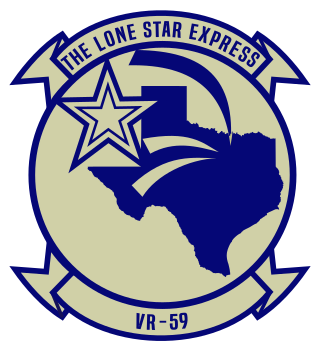
Fleet Logistics Support Squadron 59 (VR-59), nicknamed The Lone Star Express, is a transport squadron of the Fleet Logistics Support Wing of the United States Navy Reserve, based at Naval Air Station Joint Reserve Base Fort Worth, Texas. It is a reserve unit composed of both active duty and Selected Reserve sailors. The squadron maintains three modified Boeing Next-Generation 737-700C aircraft, designated as the C-40A Clipper.
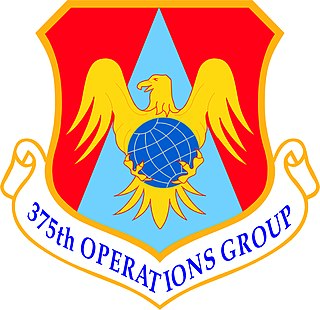
The 375th Operations Group is the operational flying component of the United States Air Force 375th Air Mobility Wing. It is stationed at Scott Air Force Base, Illinois.

Fleet Logistics Support Squadron 62 (VR-62), nicknamed the Nomads, is one of five U.S. Navy Reserve squadrons operating the Lockheed C-130T Hercules medium-lift cargo aircraft. Based at Naval Air Station Jacksonville, Florida, the squadron is manned by a combination of traditional part-time drilling Selected Reservists (SELRES) and a full-time active duty Navy Reserve cadre known as Training and Administration of the Reserve (TAR) personnel (previously known as Full Time Support (FTS) personnel from August 2006 to November 2021). The squadron is under the operational control of Commander, Fleet Logistics Support Wing(COMFLELOGSUPWING) at NAS JRB Fort Worth, Texas.

Joint Base Andrews (JBA) is a United States military facility located in Prince George's County, Maryland. The facility is under the jurisdiction of the United States Air Force 316th Wing, Air Force District of Washington (AFDW). The base was established in 2009, when Andrews Air Force Base and Naval Air Facility Washington were merged.

Fleet Logistics Support Squadron 56 (VR-56), nicknamed the Globemasters, is a transport squadron of the United States Navy Reserve providing world-wide airlift using C-40A Clipper aircraft and is based at Naval Air Station Oceana, Virginia. The squadron is under the operational control of Commander, Fleet Logistics Support Wing at Naval Air Station Joint Reserve Base Fort Worth, Texas.

Travis Air Force Base is a United States Air Force base under the operational control of Air Mobility Command (AMC), located three miles east of the central business district of the city of Fairfield, in Solano County, California, United States.

Fleet Logistics Support Squadron 51 (VR-51), nicknamed the Windjammers, is a United States Navy Reserve transport squadron of the United States Navy's Fleet Logistics Support Wing, stationed at Marine Corps Air Station Kaneohe Bay, Hawaii. It is a reserve unit composed of both active duty and Selected Reserve sailors. The squadron maintains two Boeing 737-700C aircraft, designated as the C-40A Clipper, having received their first C-40 in May 2019, with the second one arriving in July. Previously, the squadron operated the Gulfstream C-20G.

Fleet Logistics Support Squadron 61 (VR-61), nicknamed Islanders, is a transport squadron of the Fleet Logistics Support Wing of the United States Navy Reserve, based at Naval Air Station Whidbey Island, Washington. It is a reserve unit composed of both active duty and Selected Reserve sailors. The squadron maintains three modified Boeing Next-Generation 737-700C aircraft, designated as the C-40A Clipper.
